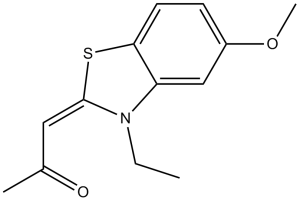TG003 (TG-003; TG 003) is a novel, potent, selective and ATP-competitive Cdc2-like kinase (Clk) inhibitor with potential anticancer activity. Its IC50 values for Clk1/2/4 inhibition are 20 nM, 200 nM, and 15 nM, respectively. TG003 exhibits no inhibitory action towards PKC, SRPK1, SRPK2, or Clk3.
Physicochemical Properties
| Molecular Formula | C13H15NO2S | |
| Molecular Weight | 249.33 | |
| Exact Mass | 249.082 | |
| Elemental Analysis | C, 62.62; H, 6.06; N, 5.62; O, 12.83; S, 12.86 | |
| CAS # | 719277-26-6 | |
| Related CAS # | 300801-52-9;719277-26-6 | |
| PubChem CID | 1893668 | |
| Appearance | white solid powder | |
| LogP | 2.381 | |
| Hydrogen Bond Donor Count | 0 | |
| Hydrogen Bond Acceptor Count | 4 | |
| Rotatable Bond Count | 3 | |
| Heavy Atom Count | 17 | |
| Complexity | 329 | |
| Defined Atom Stereocenter Count | 0 | |
| SMILES | CC(/C=C1SC2=CC=C(OC)C=C2N\1CC)=O |
|
| InChi Key | BGVLELSCIHASRV-QPEQYQDCSA-N | |
| InChi Code | InChI=1S/C13H15NO2S/c1-4-14-11-8-10(16-3)5-6-12(11)17-13(14)7-9(2)15/h5-8H,4H2,1-3H3/b13-7- | |
| Chemical Name | (1Z)-1-(3-ethyl-5-methoxy-1,3-benzothiazol-2-ylidene)propan-2-one | |
| Synonyms |
|
|
| HS Tariff Code | 2934.99.9001 | |
| Storage |
Powder-20°C 3 years 4°C 2 years In solvent -80°C 6 months -20°C 1 month |
|
| Shipping Condition | Room temperature (This product is stable at ambient temperature for a few days during ordinary shipping and time spent in Customs) |
Biological Activity
| Targets | CLK1 (IC50 = 20 nM); CLK2 (IC50 = 200 nM); CLK4 (IC50 = 15 nM) | ||
| ln Vitro |
|
||
| ln Vivo |
|
||
| Enzyme Assay | In a reaction mixture containing 200 mM Tris-HCl (pH 7.5), 12.5 mM MgCl2, 8 mM dithiothreitol, 4 mM EGTA, 1–20 μM ATP, 1 μCi of [γ–32P]ATP, 1 μg of synthetic peptide of SF2/ASF RS domain, and 0.1–1 μg of purified kinases in a final volume of 40 μL are used to measure the kinase activity of Clks and SRPKs. Regardless of the concentration of the inhibitor, the final concentration of Me2SO is adjusted to 1%. Half of the reaction mixture is spotted on P81 phosphocellulose membrane after it is incubated for 10 minutes at 30 °C for mammalian recombinant proteins and 25 °C for Xenopus recombinant proteins. The incubation time and substrate and kinase concentrations are among the parameters of the kinase assay that are optimized to preserve linearity. For at least fifteen minutes, the membrane is cleaned with either a 5% phosphoric acid solution or a 5% trichloroacetic solution. A liquid scintillation counter is utilized to quantify the radioactivity [1]. | ||
| Cell Assay | Plate 2x105 HeLa or 1.5x105 COS-7 cells resuspended in 2 mL of medium on 6-well plates; in some wells, add 2 μL of 10 mM TG003 dissolved in Me2SO (final concentration at 10 mM) or 2 μL of Me2SO. Trypsinized cells are counted every 24 hours for three days, after which the density is determined. After fixing the cells in 1 mL of ice-cold 70% ethanol, they are next cleaned with PBS, incubated for 20 minutes at 37 °C in 1 mL of PBS containing 50 μg/mL propidium iodide and 1 μg/mL DNase-free RNase A, and then subjected to cell cycle analysis[1]. | ||
| Animal Protocol |
|
||
| References |
[1]. Manipulation of alternative splicing by a newly developed inhibitor of Clks. J Biol Chem. 2004 Jun 4;279(23):24246-54. [2]. Modulation of p53β and p53γ expression by regulating the alternative splicing of TP53 gene modifies cellular response. Cell Death Differ. 2014 Sep;21(9):1377-87. [3]. Alleviation of behavioral hypersensitivity in mouse models of inflammatory pain with two structurally different casein kinase 1 (CK1) inhibitors. Mol Pain. 2014 Mar 10;10:17. |
Solubility Data
| Solubility (In Vitro) |
|
|||
| Solubility (In Vivo) |
Solubility in Formulation 1: ≥ 2.08 mg/mL (8.34 mM) (saturation unknown) in 10% DMSO + 40% PEG300 + 5% Tween80 + 45% Saline (add these co-solvents sequentially from left to right, and one by one), clear solution. For example, if 1 mL of working solution is to be prepared, you can add 100 μL of 20.8 mg/mL clear DMSO stock solution to 400 μL PEG300 and mix evenly; then add 50 μL Tween-80 to the above solution and mix evenly; then add 450 μL normal saline to adjust the volume to 1 mL. Preparation of saline: Dissolve 0.9 g of sodium chloride in 100 mL ddH₂ O to obtain a clear solution. Solubility in Formulation 2: ≥ 2.08 mg/mL (8.34 mM) (saturation unknown) in 10% DMSO + 90% (20% SBE-β-CD in Saline) (add these co-solvents sequentially from left to right, and one by one), clear solution. For example, if 1 mL of working solution is to be prepared, you can add 100 μL of 20.8 mg/mL clear DMSO stock solution to 900 μL of 20% SBE-β-CD physiological saline solution and mix evenly. Preparation of 20% SBE-β-CD in Saline (4°C,1 week): Dissolve 2 g SBE-β-CD in 10 mL saline to obtain a clear solution. Solubility in Formulation 3: ≥ 2.08 mg/mL (8.34 mM) (saturation unknown) in 10% DMSO + 90% Corn Oil (add these co-solvents sequentially from left to right, and one by one), clear solution. For example, if 1 mL of working solution is to be prepared, you can add 100 μL of 20.8 mg/mL clear DMSO stock solution to 900 μL of corn oil and mix evenly. (Please use freshly prepared in vivo formulations for optimal results.) |
| Preparing Stock Solutions | 1 mg | 5 mg | 10 mg | |
| 1 mM | 4.0107 mL | 20.0537 mL | 40.1075 mL | |
| 5 mM | 0.8021 mL | 4.0107 mL | 8.0215 mL | |
| 10 mM | 0.4011 mL | 2.0054 mL | 4.0107 mL |
